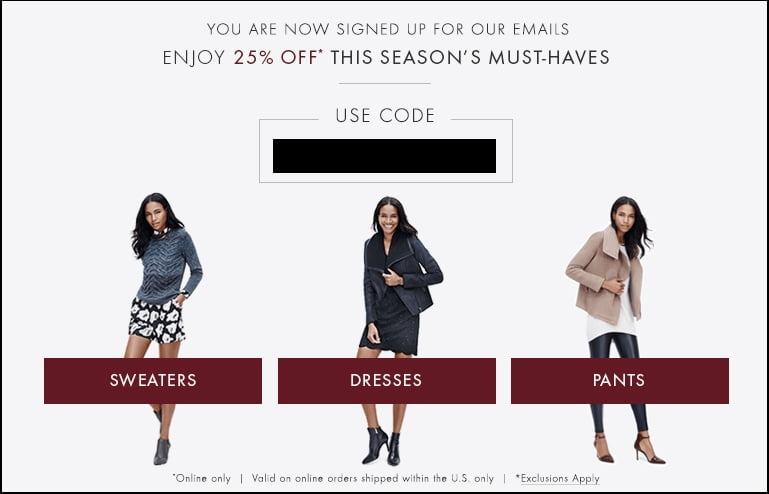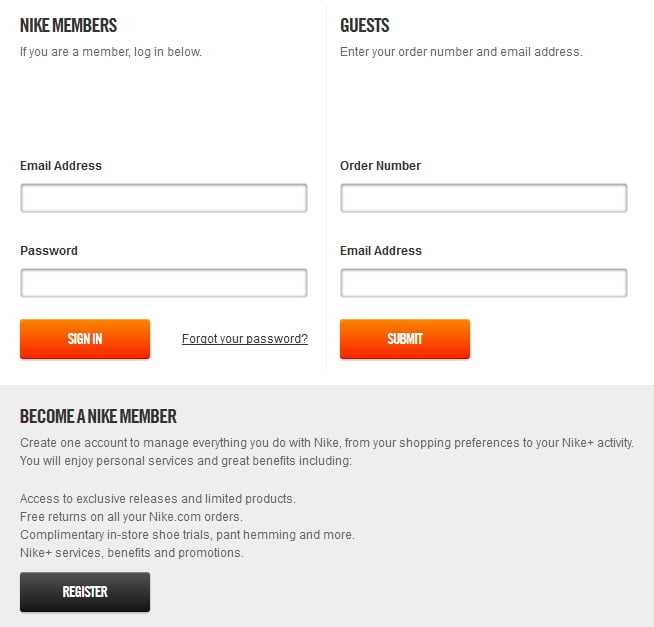Every day your email program loses subscribers. It’s a sad fact of marketing life. Even today’s most beloved brands experience annual, transparent churn rates between 25 and 50 percent. (Transparent churn includes hard bounces, unsubscribes, and SPAM complaints). Further, you’re probably losing another 10 to 25 percent of contacts due to disengagement and/or abandoned email addresses.
With so many email recipients on their way out, you need aggressive, ongoing strategies to bring subscribers back into the fold. Here are five ways to grow your email lists—especially during this holiday season.
1. Offer a discount to online shoppers, in exchange for email opt-in.
While shoppers are browsing your site, they’re especially eager to hear about a discount. So why not give them one? (In exchange for their email address, of course.) Here’s a good example from Ann Taylor. Note the clever microcopy below the CTA. “No thanks, I’d rather pay full price,” forces shoppers to consider what they’re missing by dodging the email list signup step.
If visitors bite, don’t forget to confirm their entry via email and within their current browsing session—so they can take advantage of that discount right away. Here’s how AT followed up:

2. Have in-store employees ask for email addresses.
Collecting email addresses at the point-of-sale (POS) can get hairy during the holiday shopping crunch. When store lines are 10 or 20 deep, most people will wave off the opportunity to share an email address, even if they might have been agreeable at another time. Plus, frenzied entries can lead to bad addresses. Consider assigning the task to someone other than your cashiers. For example, in-store greeters might inform customers about discount opportunities if they sign up for your email list on the spot, via mobile device.
Retailers beware: if your brand operates in California, point-of-sale (POS) email collection is actually illegal for any consumers who pay with a credit card. Check out California’s Song-Beverly Credit Card Act, which essentially states:
[SBCCA] restricts businesses from requesting or requiring “personal identification information” that is written or recorded on the credit card transaction. “Personal identification information” generally means the cardholder’s address or telephone number. But a court ruling against Nordstrom recently confirmed that email addresses are also off limits in this context, according to California law.
3. Appeal to shoppers’ eco conscience.
Direct mail consumes valuable resources in both production and delivery. As recently as 2009, glossy print catalogues accounted for 3 percent of the US’ annual paper products—more than either magazines or books! If you’re willing to forgo the marketing opportunity (which, admittedly, can be substantial) ask your shoppers to help you communicate with them in a greener fashion.
In your holiday mailers or on your purchase confirmation pages, offer an alternative to printed mail. Remind audiences that joining your email list will allow them to receive new product information, sales announcements, and electronic coupons, without wasting paper. You may even want to outline how much paper and fuel could be saved with the help of 100 of 1,000 consumers opting into email.
4. Leverage product return forms.
Returned merchandise is already costing your company a lot. Retail consultants estimate that roughly one third of all Internet sales get returned. And the numbers continue to climb—especially after the holiday season. Why not leverage return transactions into something positive (e.g. a more robust email list)?
Include an email address field on your product return forms and labels. In this example from Nike (a screenshot displayed as customers click through to access a return label), you can see how the brand turns a potentially negative experience into an opportunity to build customer loyalty and pave the way to greater lifetime value.

5. Create a refer-a –friend campaign.
This old-school tactic still works—and still works pretty inexpensively, at that—even when email permission is what you’re after. Ask your subscribers to forward loyalty program or newsletter invites to friends and family. For every five or ten new contacts they yield, you might offer a next purchase discount or some relevant freebie. Bonus tip: this kind of campaign works especially well in conjunction with social media. Don’t forget to remind folks that joining your email network will qualify them for exclusive offers, VIP events, and early access opportunities.
Now that you’re ready to tackle email list churn, it’s important to practice smart suppression list management, too. As you bring new contacts into your email program, treat them with care, respect, and generally decent social skills. Because suppression lists aren’t just good for your contacts; they’re good for business, as well. Our recent guide explains why…
![]()
